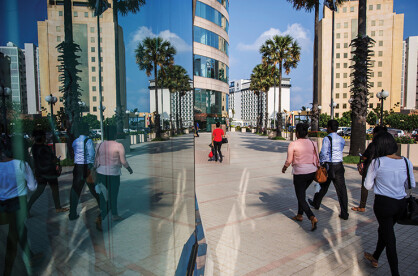China, its multilateral projects and global ambitions, is high on the global list of interests, especially given the alleged stand-off against the US and the West, and the posturing on borders with India as well as in the South China Sea. The Belt and Road Initiative (BRI) is one of China's major tools in their roadmap for increasing influence across the world. It is a manifestation of the Silk Route from historical times and works in roughly the same way.
Understanding the BRI
The BRI is a global infrastructure development strategy adopted by the Chinese Government in 2013 to invest in nearly 70 countries and some international organisations. This umbrella initiative entails a multitude of projects designed to promote the flow of goods, investment, and people, to reconfigure international relations, reroute economic activity, and shift powers between states involved.
The project includes ports, skyscrapers, railroads, roads, bridges; such as the Sinamalé Bridge, airports, dams, power stations, and even railroad tunnels. All of these different elements are used to emulate the silk road between China and the six main economic corridors of mainland Asia and the Indian subcontinent. This is, of course, the most expensive infrastructure project in history, which would involve, directly and indirectly, over 60 percent of the world’s population.
The ‘Belt’ part of the project is what connects China to Central and South Asia, the Middle East, and Europe over land, and within this is the China-Pakistan Economic Corridor, where around USD60 billion is being spent on coal, hydroelectric and wind plants, highways, and a new high-speed rail link between Peshawar and Karachi.
The ‘Road’ component ironically describes the maritime ‘silk road’ route, with connections between China and Southeast Asia, Africa, and Europe. Therein lies the major investments in ports across the world, such as in Sri Lanka, Dubai, Djibouti, Greece, Spain and spanning across to Peru in South America.
Cooperative effort
The BRI aims to not just connect China with the world, but to also build links between the nations involved in the project, fostering and promoting trade in whichever direction. It is an open-ended project thus far, with no specifics on the exact number nor types of projects, although there are currently an estimated over 2,600 projects spanning 100 countries. This would most definitely raise the expenditure to over a trillion dollars even by the most conservative estimates.
China is, without a doubt, leading in material imports as well as in exporting value added goods, so the BRI opens up this vast trade line, serving as the biggest advantage for China. Given our exploration above, the political implications are boundless, creating stronger interdependencies between countries given the physical connectivity that allows seamless trade to begin. This project will have lasting effects on trade development, and outreach, for these countries as well.
However, the more important takeaway is how this offers the opportunity to establish more sophisticated infrastructure in underdeveloped countries, catapulting them hopefully to catch up with first-world international standards. The difference between the BRI and the West and their projects is the lack of conditions attached to these projects, at least on the face of it – what happens when one defaults on the loans availed can of course be seen from various corners of the world, the closest example to the Maldives being the Hambantota Port in Sri Lanka. The World Bank, however, has estimated that the BRI can help alleviate poverty for more than 7 million people, while boosting global trade by up to 6.2 percent as it stands today.
The Maldives in the grand scheme of things
In the most recent meeting, in January 2022, between President Ibrahim Mohamed Solih and the Chinese State Councillor and Foreign Minister Wang Yi, both parties pledged to work together in strengthening ties between the two countries. Wang Yi had also met with his Maldivian counterpart, the Maldives' top diplomat, and that of the world in terms of the UNGA Presidency, Abdulla Shahid during his visit, and Shahid has pledged that the Maldives will join hands with China to expand the BRI, emphasising the post-pandemic recovery of the country.
Wang Yi, during his visit, also signed an agreement providing a whopping USD63 million for social and infrastructure development projects in the Maldives. While these projects will be more dispersed compared to the massive bridge project it provided financing for during the Yameen administration, they are equally important, providing impetus to the Maldives’ post-pandemic economic recovery efforts. China also agreed to provide for the maintenance of the China-Maldives Friendship Bridge, commissioned in 2018, as well as a host of other memorandums and understandings.
Surprisingly, Wang also highlighted the Free Trade Agreement signed between the two countries during the Yameen administration and said that he looked forward to the FTA being implemented.
"China and the Maldives are now jointly constructing the Maritime Silk Road, and that coincides with the mutual interests of the two peoples,” Wang said, adding that the two countries are “jointly building a road of hope, prosperity and happiness.”
The red pill / blue pill conundrum
The Maldives may not feel as influential in global politics and trade as of yet, but that may very well change in time. It's strategic location in the Indian Ocean coincides with multiple shipping routes, which, if capitalised on with more port facilities and direct involvement, will likely result in an economic boom and put it in a position of influence. It is also a location that has multiple naval warfare advantages, a fact which the US and India have never shied away from focusing upon.
The uncharacteristic move by the Solih Administration to bolster ties with China, in the face of Indian influence, warrants watch and may deal a more sophisticated hand to play in diplomacy. The people, however, need to be aware that all these steps and deals and projects undertaken will more importantly have lasting consequences.







